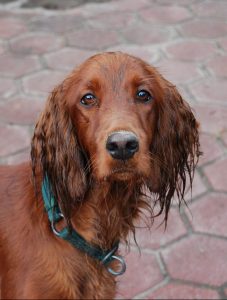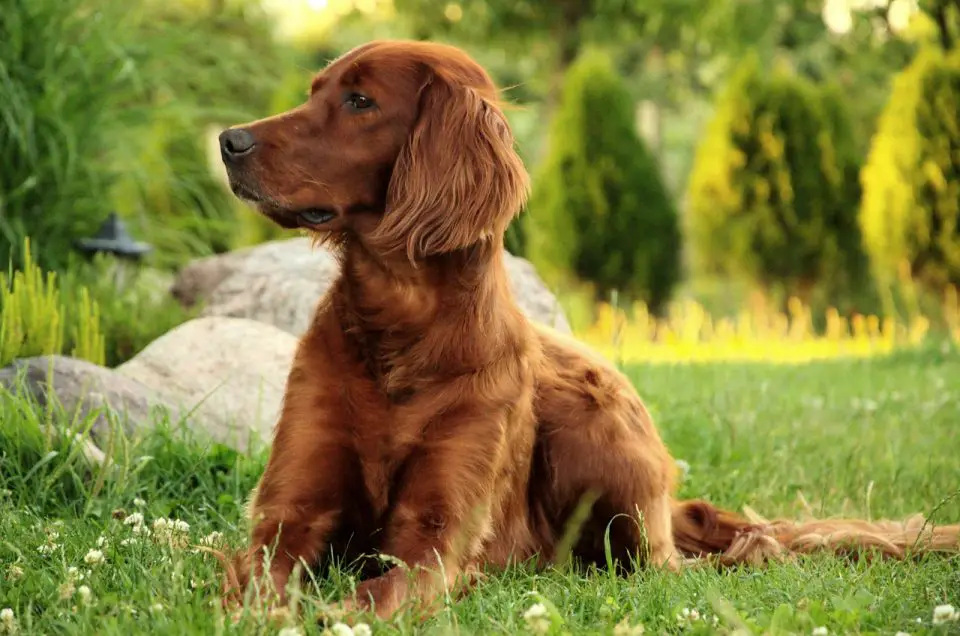A Little About Irish Setters
You may also know this breed as Red Setters. They’re part of the breed of gundogs, although they have evolved to make wonderful family pets.
The breed is recognised by the AKC as well as the Field Dog Stud Book.
My friend is considering getting one of these dogs but is concerned as she suffers from seasonal allergies and has Asthma. I decided to do some research and find out what I can about them.
I see that both the FCI and the ANKC say that this breed is ‘demonstrably affectionate.’
They get on well with kids and other dogs, they love visitors but although they are fine with most other pets, small dogs may be an issue as the breed is from hunting stock.
Irish Setters are an active breed so if you don’t have the time for a good walk at least twice a day then this breed may not be the right one for you.
These dogs love having a task – something to do. Lack of activity can lead to them becoming bored and often destructive.
They do not enjoy being left alone for long periods of time as they thrive on human companionship. They are also easy to train and highly intelligent.
Not being a naturally assertive breed, they do not make good guard dogs although they are widely used as therapy dogs. You may have seen them visiting patients in hospital.
Short History of the Irish Setter
The first record of an Irish Setter was found in 1570 where the dog was a hunter. Originally the coat was multi coloured but with selective breeding the coat has become deep red.
By the 18th century the Setter had come into its own right and the Irish had begun a breeding programme of their own.
At that time, they were predominantly red, red and white or pale yellow. In 1845 they were mostly dark red.
The breed standard came into effect in March 1886 where it was drawn up by the Irish Setter Club and it remains largely the same today with only some minor changes made to it.
What is an Irish Setters Coat Like?
The Irish Setter coat is classed as moderately long and of red or chestnut colour.
The breed has two coats, namely a topcoat and an undercoat. The undercoat is very dense in the winter with the topcoat being fine and silky.
The coat is normally feathered around the ears, tail, chest, legs and body.
Do Irish Setters Shed?
The answer to this is very simple – yes, they shed. And yes, they shed a lot. The breed needs regular grooming to keep the coat tangle free and smooth.
If this is a dog that you want as a pet, then you need to be prepared to get the vacuum out on a daily basis as they will drop hair all over the place.
Furniture and clothing will all have hair on them, even with regular brushing.
How Much do Irish Setters Shed?

The Irish Setter will shed twice a year, namely at the end of spring and autumn when they get rid of the winter coat and then grow it back again.
The breed is classed as moderate shedders, but simply because the hair is so long and the dog is quite large, you will find hairs left most days.
While they do not shed as much as other breeds, they will drop hair and you will need to sweep it up.
When do Irish Setters Shed the Most
The Irish Setter moults during spring and autumn – and they do this heavily. They continue to drop hair through the year but not as much as at these times.
Even as pups they will shed, and it will become more noticeable as the adult hair starts to grow.
Bad diets and illnesses may cause the Irish Setter to drop more hair than is normal, and if you see this, then you should take your pooch to the vet for a check-up.
How to Combat Irish Setters Shedding
If you do not brush and groom the Irish Setter often you will always have a hair issue on clothing and furniture.
Brushing is the best way to keep shedding down to the minimum. It is also necessary to brush to stop the long hair from forming knots and tangles.
In extreme cases you may have to shave the dog to remove the mats.
A bath every two to three weeks will help to a certain extent to keep shedding down, as will brushing your dog outside.
At least some of the hair will blow away instead of landing on furniture.
Unless you plan to show the Irish Setter, you may want to keep the hair a little shorter to keep shedding down a little.
Equipment Help to Combat Irish Setters Shedding
The following pieces should be added to your grooming basket for the Irish Setter, namely:
- Good quality bristle brush
- Pin brush
- Wide-toothed metal comb
- Fine comb
You may want to add a set of scissors to trim around the ears and eyes, and between the toes where the hair can become knotted.
Are Irish Setters Considered to be Hypoallergenic?
No dogs are truly hypoallergenic, and the Irish Setter does not even come close to taking this attribute. They are most definitely not hypoallergenic.
If you are allergic or suffer from allergies of any kind, then you may want to consider another type of dog who does not shed as much as this breed.
Do Some Irish Setters Shed More Than Others?
Some breeds have variations of the coat, particularly if they are from two different parents, such as the ‘Doodle’ breed.
With the Irish Setter there are only parents of the same breed, so the hair never varies from dog to dog.
You can expect any pedigree Irish Setter to have the same hair type as the next. The colour may vary slightly but they will all shed in the same way – and shed a lot during the season.
Health Reasons for Increased Shedding in Irish Setters
The Irish Setter is a healthy breed which do not as a rule suffer from too many allergies.
An inferior diet may mean that the dog sheds more than normal so make sure to include all the nutrition the dog needs. Your vet will be able to tell you what the breed requires to keep the hair smooth and shiny.
Dogs who are pregnant or lactating may suffer from extra hair loss, although this will pass as soon as the dog has given birth.
Because of the long coat, they may suffer from fleas and this will cause the dog to scratch and even make a bald spot on the skin.
Final Thoughts
 This is a beautiful and loyal breed who sport an amazingly smooth and silky coat. The downside is that the breed is known to be shedders.
This is a beautiful and loyal breed who sport an amazingly smooth and silky coat. The downside is that the breed is known to be shedders.
If you do not have the time for long walks and good grooming sessions, then another breed may be better suited for you.
If you can handle the dropped hair and regular grooming, then you may find this loyal companion the right dog for you.
